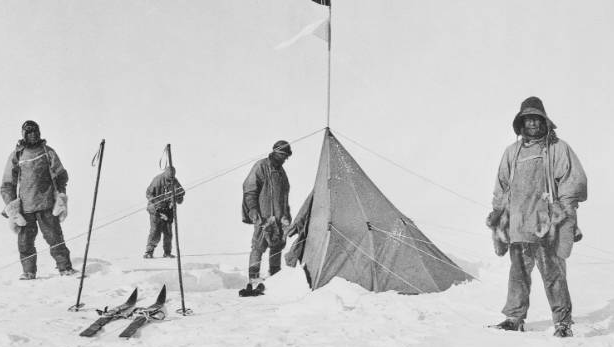I have had for many years a pair of seal mitts that have performed amazingly well for winter cycling. Many people prefer to use pogies for cold weather riding and I too often find them useful, but on extended cold weather cycling expeditions actual cycling only accounts for some of the time and chore list. Setting up and breaking down camp typically happens during the coldest time of day. Warm mittens are needed throughout and with all things bike expedition, why carry two of something if one will suffice.
My very close family friend, who I consider an aunt, made my seal mittens - anana Umara. She is Siberian Yupik and grew up on St. Lawrence Island learning to sew skins from her mother.
My mitts are made of fur seal and the fur is facing out on the top, thumb and underside of the forearm. The palms were originally made of tanned moose hide. With a few years of serious use the moose hide palms began to deteriorate. After debating options I decided to replace the palms with Cordura. This modern fabric is waterproof and tough. After two years, the repair has proven successful. As an aside, I enjoy the aesthetic – modern primitive.
My partner Kim has been without fur mitts and on previous winter expeditions her hands have suffered as a result. For this winters expedition we decided to amend her deficiency and bought a beaver pelt to sew into mittens. Beaver has coarse guard hairs but very dense ‘down hair’, making it warm and soft and a good choice for mittens.
My seal mitts were made of four individual pieces, hand stitched together with dental floss. I used this pattern and tried to mimic, as close as possible, the workmanship for Kim’s pair.
Step one was laying out the pelt, tanned side up, and tracing a pattern. Once the layout was complete I used a razor knife and cut out the pieces of hide, making sure to only cut the hide and not the fur. I then moved to the cordura and cut out the palm piece.
Sewing fur has many tricks and I have much to learn, but one technique I picked up along the way was to sew through the hide, tanned side first. The other direction causes the needle and thread to bind with the fur and pull it through the stitch. This is time consuming and messy looking.
I sewed the palm to the top piece of hide inside out until I reached the thumb and wrist intersection and stopped. I then turned the mitten right side out and attached the thumb piece with a few pins. Keeping the mitten right side out, I sewed the thumb on using a baseball stitch.
At this point I had three unfinished intersections - two at the thumb and one at the wrist. I then pined the final piece, the bottom of the forearm, and continued to sew with the baseball stitch right side out. Once all the seams were done on the bottom forearm, I turned the mitten inside out and finished the intersections.
The mitten looked done at this point but there were a few steps remaining. A band of trim is needed at the opening, a tethering system and lastly I used a conservative amount of seam seal on the stitches.
For the trim I used a strip of one-inch cordura, overlapped the opening and hand stitched through the three layers. This piece of trim serves to protect the fur, is an attachment point for the tether and has a nice aesthetic.
The tether I use is based on images I have seen from turn of the century polar explorers. I use one inch webbing and sew four pieces together at right angles making a rectangle shape, big enough to easily fit over your head with hat(s) and hood on. I then sew either webbing or chord to the middle of the ends of the rectangle slightly longer than shoulder to wrist and attach the other end to the cuff/trim of the mitten. The tether should be long enough that your range of motion is never restricted but not too long as to become a nuisance. These mittens are loose fitting and it is ideal to be able to shake them off when dexterity is required and then easily slip them back on.
Layering is the key to this kind of mitten. Temperatures can fluctuate wildly on long winter trips. Being able to regulate is very important. The outer layer should be too big to be worn with nothing else but supple enough to work with only a thin liner glove. The liner glove is the first layer but all subsequent layers are mitts. I typically carry two home made fleece liner mittens - one thin and snug fitting the other thick and loose enough to fit over the liner glove and liner mitt. They should all fit together without constriction. For cold weather, tight fitting and constricting gloves and footwear are to be avoided at all cost, as this leads to poor circulation and eventually frostbite.
Many people have strong ethics and feelings against using natural furs for clothing. For me, this is a complicated issue. On the one hand I am against unnecessary cruelty and believe fur farms are often a terrible idea. On the other hand fur trapping is a small part of Alaska’s sustainable economy and there is no doubt that indigenous people figured out what works best against the cold. Every item we use in life has some hidden, external cost associated with it. I personally try my best to be ethical in my purchases and weigh out the pros and cons. For me, this beaver is sacred. I can only hope that it lived a fruitful life, had offspring and died without unnecessary pain. It will now live on and provide warmth to another being who is greatly appreciative.
Beyond the mittens I also sewed seat covers for our bike saddles, using two pieces of hide and a tube of cordura around the bottom perimeter, with a chord to tighten the cover onto the saddle. In the past we have used sheepskin saddle covers with great results. I believe the beaver saddle covers will be an improvement over the sheepskin.
Next blog post will be about retrofitting a floorless mid shelter to work with a wood stove.






